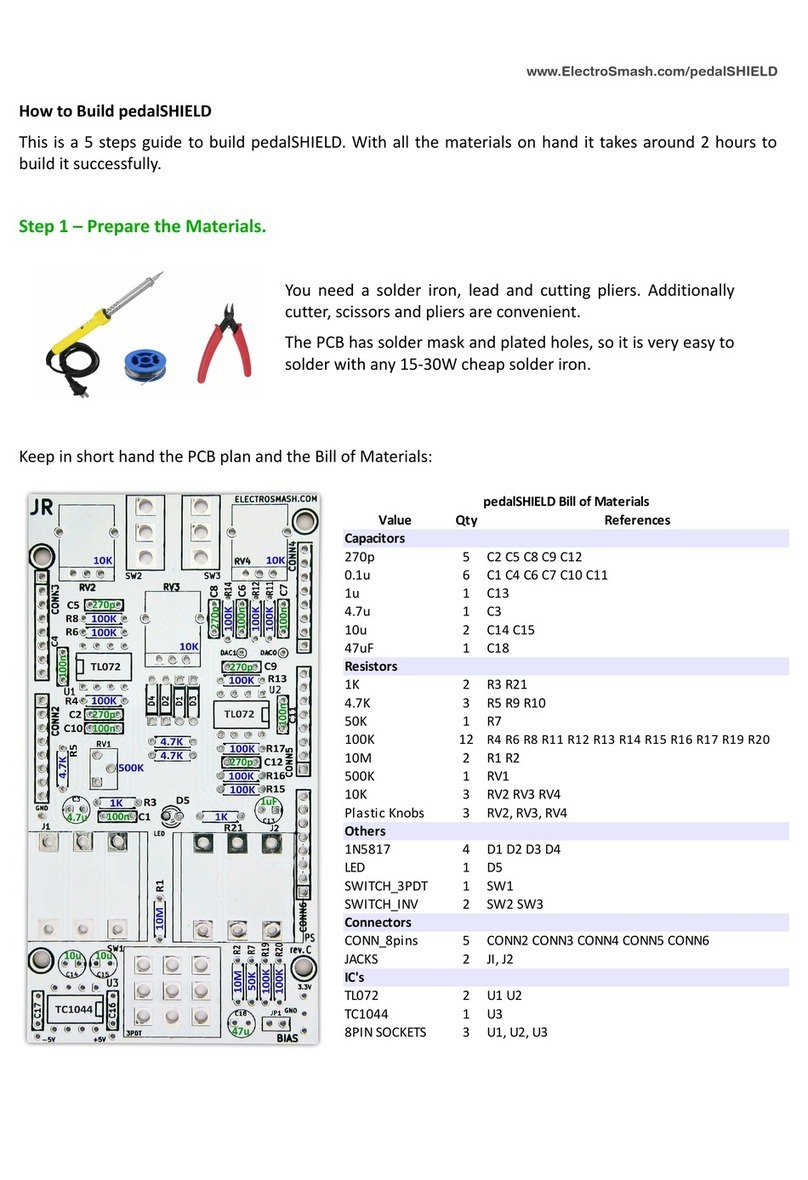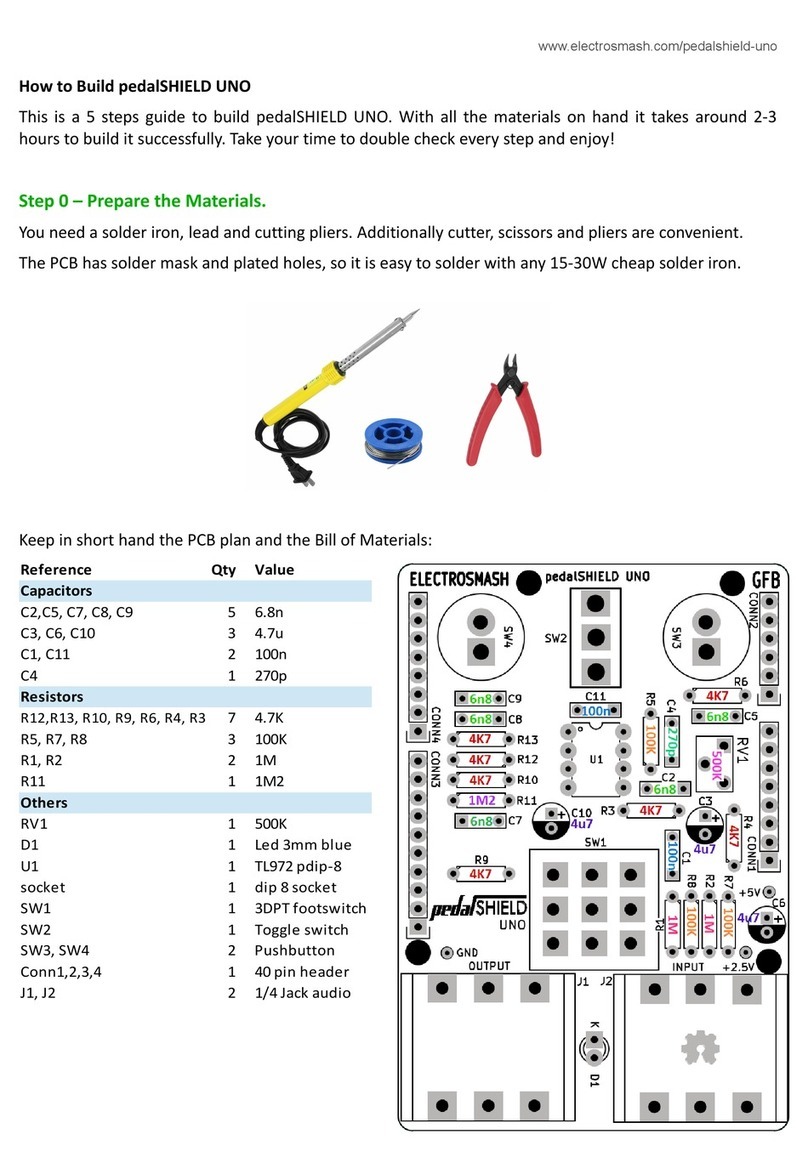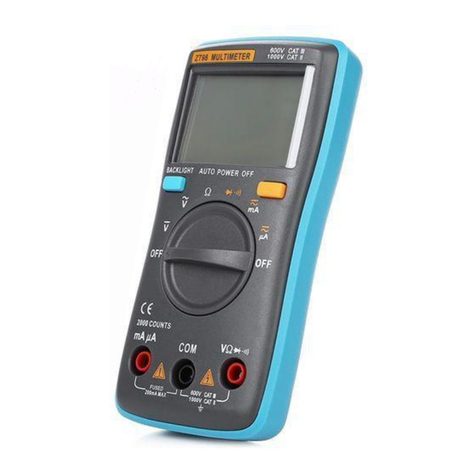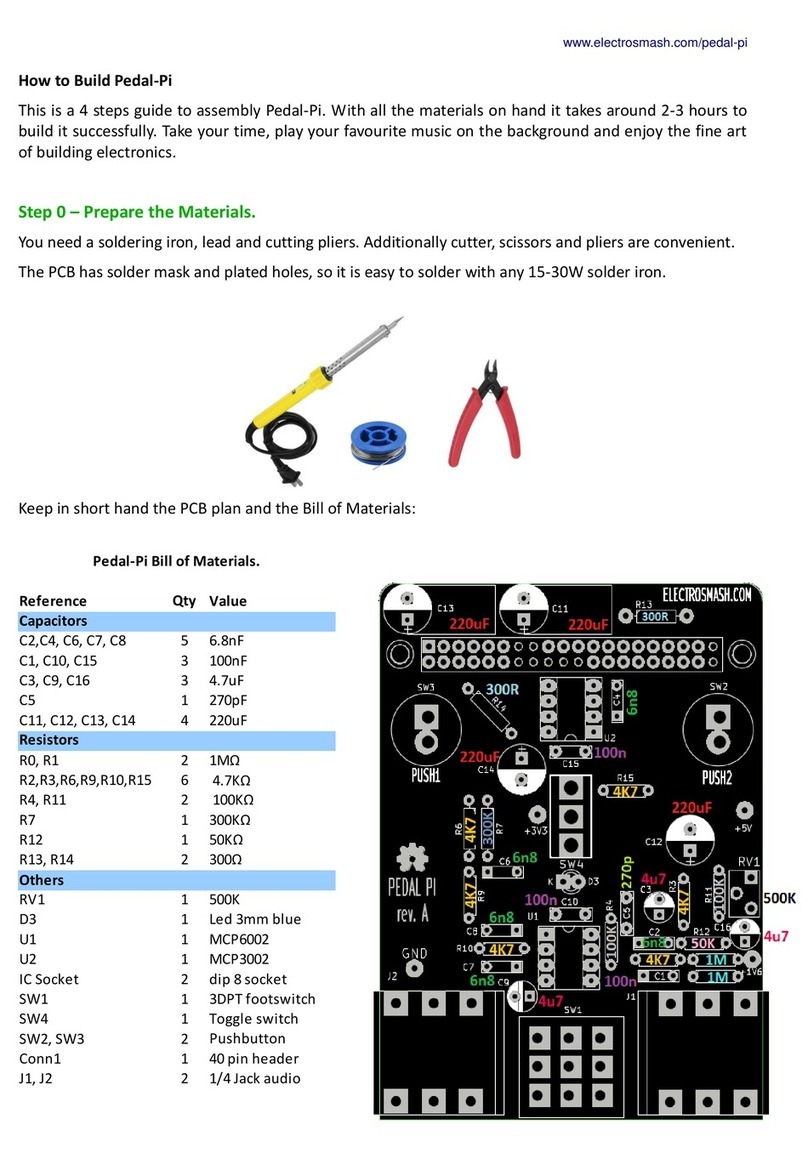ElectroSmash Germanium Fuzz User manual

How to Build a Germanium Fuzz Guitar Effect.
This document will guide you to build and test your Germanium Fuzz guitar pedal.
With all the materials on hand, it takes around 2-4 hours to build it. Try not to rush
and take your time. Play your favourite background music and enjoy the fine art of
building your own guitar effects.
We have a YouTube video in the ElectroSmash channel that will help you during the
assembly.
We strongly recommend reviewing the entire instructions before starting. It takes 2
minutes and may save you hours of frustration.
This guide aims to build and test the circuit at the same time in a logical order.
Following all the steps will ensure a successful assembly.
STEP 0 – Prepare the Materials.
You would need:
Soldering iron with a small tip.
Solder wire.
Cutting pliers.
Multimeter.
Germanium Fuzz Kit.
Keep in short hand the PCB plan and the Bill of Materials.
PCB Plan PDF.
Schematic PDF.
Bill of Materials PDF.
1590B Fuzz Drilling Stencil PDF.

Long lead, positive +
Short lead, negative -
Line marked on the negative side
STEP 1 – PCB Assembly: Turrets & Small Components
*Note: The electrolytic caps have polarity, insert the long lead into the hole labeled
with “+”
Placing the Turrets:
The turrets are very simple but they could be
tricky to do when the PCB is crowded, so let’s place
them first to have a neat job.
Don’t cover the hollow centre of
the turret you can just add a
little quantity of solder to keep it
in place. Later on, the turrets will
be fully soldered.
Place the Small Components.
Place R0, R3, D1 (take care with the polarity
which is indicated with a line) and C4 (bottom
side, also with polarity*).
Once soldered, cut the legs as close as possible to
the PCB because the electronics fit tight into the
box and you will need those millimetres.
Top
Side
Bottom
Side

STEP 2 – Place the bridge cables.
Note: These cables will connect the PCBs between them. You can pre-form the cables
in a round and smooth “U” shape by bending them with a curved object (pen). Don’t
force the cables many times or do hard bents, they may break.
STEP 3 – Place the big components.
Top
Side
Bottom
Side
Solder on
top side
Solder on
bottom side
Solder on
top side
Solder on
bottom side
Important:
Once soldered,
cut all the Jack
pins as close
as possible to
the PCB
Make sure
there are no
short circuits

+9V
Solder the input/output jacks (J1, J2), the 3PDT True Bypass footswitch (SW5), and
the 9V battery clip.
Note: The big components tent to tilt when soldered. Make sure they are straight: A
good idea is to solder only one pin and once you are sure that it is perpendicular,
solder the rest of the pins.
Note:
STEP 4 – Testing the Power Supply.
At this point, the power supply of the circuit could be checked. Place a mono guitar
cable at the input jack, a 9V battery and make sure that the footswitch is activating
the pedal. The led should light and the following voltages read:
This is a detail of how the battery
cables have to be soldered:
+9V
+9V
0V
+9V
+9V
Red to +9V and
black to GND
0V
↑ Input jack
Battery needed

STEP 5 – Place the Audio Components:
These are the most important components for the sound. You have to place R1, R2,
C1, C2, C3, Trimmer1, Trimmer2, RV1 (1K pot), RV2 (500K pot), and the spring.
Note: Before placing the Trimmers, you have to pre-set them to a good value. Using
a multimeter in resistor mode (Ω) measure between pins 1 and 2, adjusting them to:
*Note: Take care that the spring does not touch any pads; it has to be raised 3mm.
Note: Do not solder the LED, just place it in the holes, but don’t solder it yet.
Trimmer1: 33KΩ
Trimmer2: 8.2KΩ
Note: It is a good idea to mark where the turret board
components need to be bent using a marker pen.
*

STEP 6 – Place the Germanium PNP Transistors.
The germanium transistors have a dot that indicate polarity,
place them on the PCB following the same dot.
Note: The transistors have to be close but not touching each other.
If you have transistors with different gains (Hfe), it is better to use the one with lower
gain as Q1 and the one with higher gain on Q2.
Q1 = lower gain.
Q2 = higher gain.
Note: The potentiometer little leg is not needed, so you can cut it
Axial electrolytic cap polarity:
rubber top metal top

Bias the Q1 & Q2 Transistors:
Although we pre-set the trimmer resistors to a good value in the Step 5. Now it is
time to make sure that the Fuzz is biased to the perfect point.
Note: The bias point will depend on the temperature, so it may change during the
time. So, don’t try to get a super-accurate bias level. As far as the values are close
to -0.7 and -4.5V it will be great.
Input jack needed to power it up
9V Battery needed
Multimeter on Voltage setting,
Negative probe attached to the
spring (+9V) and Positive probe to
TP1 or TP2
With Timmer1 adjust TP1 to
-0.7 ~ -0.5V
With Trimmer2 adjust TP2
to -4.5V

STEP 7 – Check the Board:
Make sure that your board looks exactly like the one below:
Note: The LED is still not soldered, once inside the enclosure you can adjust the
perfect length for the leads and solder it.
Note: The 100pF Cx Miller capacitors are optional. They help to reduce the noise of
the pedal but also may affect the fuzz tone. You can try them, although the original
Fuzz did not include these parts as the effect was made to be organically noisy.
This is the perfect time to try the pedal and make sure that works and sounds good.

STEP 8 – Boxing
Now that the electronics are finished, let’s prepare the enclosure.
The Germanium Fuzz uses a standard Hammond 1590B. You can use a pre-drilled
box or drill your own using the 1590B Germanium Fuzz Stencil.
Use a cutter to separate the stickers and place the black pad on the bottom:
Place the 2 plastic insulators (one need to be cut following the stencil) using double
side tape, they will protect the electronics:
Leave the battery
area free from
insulation
Cut
following
the stencil
At the last page of
this document, you
can see how the
stickers are placed.

After placing the 5mm metal LED holder, you need to box the electronics, take your
time and be patient:
Make sure that all the soldered parts have their legs cut as close as possible
to the PCB
Don’t force the parts into the holes –be gentle- , they are designed to be tight
but not forced. If they seem to be stuck, remove the electronics and start
again.
The best way to enclose the board is to try to fit all the parts through the holes
at the same time (not simply inserting one jack after the other).
It is easier is you start with the 2 jacks, the LED and the footswitch (inserting
the 4 of them on the holes at the same time).
Note: The LED has to be placed but not soldered yet. The
negative pin (shorter on the flat side of the LED) goes into
the square hole, and the positive pin into the upper round
hole.
When all is in place, you can finally fit the washers & nuts and solder the red LED.

This is the final finished project:
Other ElectroSmash Music Pedal manuals




















